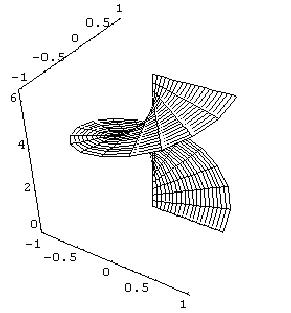Calculus IV Exam 3 Fall 1998 11/19/98
Each problem is worth 10 points. Show all work for full credit. Please
circle all answers and keep your work as legible as possible. Danger: Not
responsible for losses due to unexpected thawing.
1. Compute  where C is a counterclockwise arc of the ellipse 4x2 + 9y2
= 36 beginning at (3,0) and ending at (0, -2).
where C is a counterclockwise arc of the ellipse 4x2 + 9y2
= 36 beginning at (3,0) and ending at (0, -2).
2. Compute  if C is the portion of the parabola y = x2 from (0,0) to (2,4).
if C is the portion of the parabola y = x2 from (0,0) to (2,4).
3. Show that the line integral in problem 2 depends on the path C taken
from (0,0) to (2,4).
4. Calculate  where S is the surface of the rectangular box bounded by the planes
x=0, x=3, y=0, y=2, z=0, and z=1.
where S is the surface of the rectangular box bounded by the planes
x=0, x=3, y=0, y=2, z=0, and z=1.
5. When the ice sheet that forms over much of the arctic in winter
breaks up during the spring thaw, occasionally a polar bear ends up floating
off on a small iceberg which might be caught by ocean currents and swept
out away from shore. Suppose this were to happen to a bear named Harvey,
and he floated for weeks until the ice pretty much melted away to a piece
just big enough for him to sit on. Then, unfortunately for Harvey, his
ice raft gets caught in a rare ocean whirlpool effect like the vector field
F =  .
Use a line integral to compute the amount of work (i.e.,
.
Use a line integral to compute the amount of work (i.e.,  )
for Harvey to paddle his ice raft once around the whirlpool (counterclockwise
of course) along a circle of radius 10 meters.
)
for Harvey to paddle his ice raft once around the whirlpool (counterclockwise
of course) along a circle of radius 10 meters.
6. Explain how you can use the fact that curl(grad f) = 0 for
any function f with continuous second partials to conclude that F
= xyi - 2yzj + x3zk does not have a potential
function.
7. Show that if F(x,y,z) is any constant vector field and G(x,y,z)
= xi + yj + zk, then curl(F G)
= 2F.
G)
= 2F.
8. Show that the surface area of the helicoid (spiral ramp!) with parametrization
x(u,v) = u cos v, y(u,v) = u sin v, and z = v, within the region S,
is given by  .
.

9. Biff says "So I was doin' this homework for calc, and there's somethin'
I don't get. There's this problem about doin' the line integral of this
function F =  on a circle with radius 2 goin' round the origin. The book says it's 2
on a circle with radius 2 goin' round the origin. The book says it's 2 ,
but I used the Green's thing and got it to be zero. Is the book just wacked
or what?"
,
but I used the Green's thing and got it to be zero. Is the book just wacked
or what?"
10. Show that the flux of the vector field F(x,y,z) = xi
+ yj + zk outward through a smooth closed surface S
is three times the volume V of the region E enclosed by the
surface.
Extra Credit (5 points possible):
The book gave a couple alternate statements of Green's Theorem in the
section on curl and divergence. In one of these the expression  is replaced with
is replaced with  .
Show that these are equivalent (Remember F = Pi + Qj
+ 0k).
.
Show that these are equivalent (Remember F = Pi + Qj
+ 0k).
